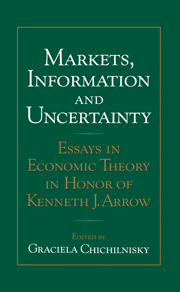Book contents
- Frontmatter
- Contents
- Preface
- List of contributors
- Section I Information and markets
- Section II Uncertainty and finance
- 3 The formulation of uncertainty: Prices and states
- 4 A remark on incomplete market equilibrium
- 5 Existence and optimality of a general equilibrium with endogenous uncertainty
- 6 Market equilibrium with endogenous price uncertainty and options
- 7 Catastrophe futures: Financial markets for unknown risks
- Section III Market externalities and justice
- Author index
- Subject index
6 - Market equilibrium with endogenous price uncertainty and options
Published online by Cambridge University Press: 05 December 2011
- Frontmatter
- Contents
- Preface
- List of contributors
- Section I Information and markets
- Section II Uncertainty and finance
- 3 The formulation of uncertainty: Prices and states
- 4 A remark on incomplete market equilibrium
- 5 Existence and optimality of a general equilibrium with endogenous uncertainty
- 6 Market equilibrium with endogenous price uncertainty and options
- 7 Catastrophe futures: Financial markets for unknown risks
- Section III Market externalities and justice
- Author index
- Subject index
Summary
Introduction
Arrow's (1953) classic two-period general competitive equilibrium model introduced the canonical theoretical setting for the study of market behavior under uncertainty. The types of randomness described by Arrow's formalization are those factors external to human influence, such as hurricanes, earthquakes, droughts, and floods, that affect production capabilities or consumer tastes. In one bold stroke, Arrow (1953) and Debreu (1959), with the introduction of a complete set of contingent commodity markets, reinterpret the static Arrow and Debreu (1954) model of certainty in terms of a sequential model of uncertainty. This reinterpretation allowed their results about existence and Pareto optimality of static competitive equilibria to carry over completely to a dynamic and uncertain world. Arrow's (1953) model also provided what has become the standard role for securities, namely hedging against exogenous risks by shifting income across exogenous states. As Duffle (1991) noted, Arrow (1953) and Arrow and Debreu (1954) provided financial economists with benchmarks for market behavior that had been missing until then.
In Arrow's paradigm, uncertainty means not knowing which of several possible states will prevail. Agents are assumed to know all the conceivable states that can arise. These states are assumed to form a mutually exclusive and exhaustive description of the future. Arrow's conceptualization of states of nature is related to, but differs from Savage's (1954) definition of personal states of the world for subjective probabilities in statistical decision theory because the state space must be agreed on by everybody in Arrow's framework in order to have markets for either contingent commodities or securities.
- Type
- Chapter
- Information
- Markets, Information and UncertaintyEssays in Economic Theory in Honor of Kenneth J. Arrow, pp. 97 - 119Publisher: Cambridge University PressPrint publication year: 1999
- 3
- Cited by



